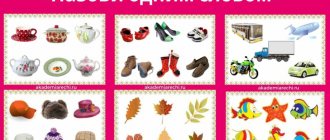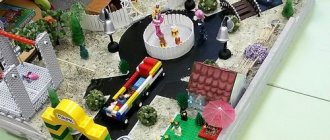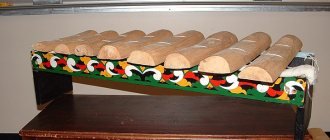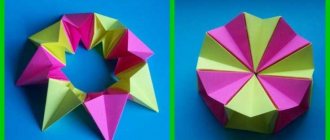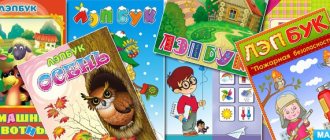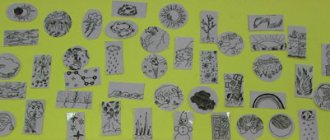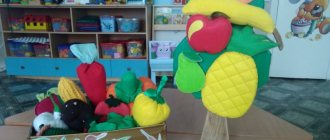Didactic manual “Miracle Tree” for kindergarten
Didactic manual “Miracle Tree” for preschool children
Didactic manual “Miracle Tree”
Description. I bring to your attention the teaching aid “The Miracle Tree”. The material is intended for kindergarten teachers. The manual can be used on lexical topics “Birds”, “Fruits”. And also for automation and differentiation of sounds. Multifunctionality lies in the use of different pictures. The manual is designed for individual and subgroup work with preschool children. Method of making the manual. Take a sheet of A4 paper, draw a picture of a tree on it or use a ready-made image. Laminate it with film for pasting textbooks.
Cut nest-pockets from transparent film and attach to tree branches using double-sided tape.
Select pictures of birds and cover them with tape.
Didactic game “Birds in nests”
Purpose: To consolidate children’s knowledge and ideas about migratory and wintering birds. Clarify the name of the birds, practice recognizing birds by their description. Learn to coordinate nouns with numerals. Develop phonemic awareness, determine the presence of sound in a word. Automate the sounds L, R, Rub, S. Game options.
1 task “Say it in one word”
Pictures of birds are laid out in front of the child. The teacher asks the child to name who is shown in the pictures. Then he suggests choosing a generalizing word.
Task 2 “Wintering birds”
The teacher invites the child to select and place only wintering birds in the nests. The child resettles the birds by pronouncing their names.
Task 3 “Count and name”
The teacher places the birds on the tree and asks the child: “How many birds have arrived?” The child counts the birds and sums them up at the end of the count. For example, one rook, two rooks...five rooks. Five rooks flew in.
Task 4 “Where is the bird sitting?”
The teacher invites the child to place the birds on a tree branch, above a tree, under a tree, on a branch. The child seats the birds, pronouncing their location.
— A crow over a tree. - Magpie on a tree. - Rook under the tree. — The sparrow is to the right of the tree. — The rook is to the left of the tree. The teacher monitors the correct use of prepositional-case constructions.
Task 5 “Find out by description”
The teacher asks the child to guess riddles about birds. Nimble, fast, dexterous, pugnacious, brave, fighting ... (sparrow) Red-headed, large, smart, wintering ... (woodpecker) Nimble, cheerful, long-tailed, migratory ... (swallow) Big-eyed, sleepy, nocturnal, sedentary, wintering ... (owl) The child guesses the bird, names it and places it in the nest.
Task 6 “Birds in nests”
The teacher asks the child to place in the nests only those birds whose names contain the sounds S, S'. Similarly with the sounds R, Rb, L.
Task 7 “Who flew away?”
The teacher places birds on the tree whose names contain the sound S. Invites the child to look carefully and remember the birds. Then the child closes his eyes, and the teacher removes one bird. Who flew away?
Task 8 “Who’s the odd one out”
The teacher places birds in nests: jackdaw, swallow, dove, oriole, woodpecker, falcon and crow. Invites the child to look carefully and find the extra bird whose name does not have the sound L.
We recommend watching:
Do-it-yourself multifunctional game aid for preschoolers Do-it-yourself didactic aid for younger preschoolers Do-it-yourself didactic aid for kindergarten Do-it-yourself didactic aid “Paired Pictures” for kindergarten
Similar articles:
Game layout for children 4-7 years old “My City”
Multifunctional teaching aid for children 5-6-7 years old
Do-it-yourself manual for developing fine motor skills
Goal: formation of perception of color, shape, size of objects. Objectives: Educational: Teach children to group objects according to one of the characteristics: shape, color, size; Acquaintance with the surrounding world, with natural phenomena; Fix the names of wild and domestic animals; Exercise children in identifying and naming colors, sizes, shapes, geometric shapes, through visual and tactile examination and comparison. Developmental: Develop fine and gross motor skills, coordination of movements; Develop tactile sensations, visual and auditory perception; To develop the ability to correlate forms with real objects; Enrich children's vocabulary, the ability to use speech as a means of communication; Develop attention, memory, thought processes. Educational: Cultivate curiosity, expand the experience of orientation in the environment, enriching children with a variety of sensory impressions; Foster mutual understanding, friendliness, and respect for each other.Progress of the game
I. _ SENSOR MAT. This is such a wonderful clearing - Come on, play with us. To become smart, we need to touch everything.
We examine the object - We highlight the shape, color. Think Vova, Sasha, Dasha. Help with our fingers. One, two, three, four, five Let's count fingers Strong, friendly These are so necessary.1. To keep the trailer on the road, you need to tighten the wheels. The colored trailers run, run, run, and the round wheels go on and on. The locomotive began to whistle and the carriages began to move. Chu-chu-chu, I'll rock you far.
2. We are going, going, going, to distant lands. Here are hares and bears, cheerful friends.
Game "Train" . Invite children to place a wild or domestic animal in the trailers. Goal: learn to name colors, consolidate the names of animals, develop speech.
3. It’s time for all of us to know this wonderful game. Here is a circle and a square, they all lie in a row. Come on, my dear friend, show us the circle.
Game "Form" . Find a shape similar to a square, triangle, etc. Goal: learn to name a geometric figure, the ability to relate shapes to real objects.
4. Here is a wonderful shoe, untie it, my friend. Someone is hiding inside, try and unfasten it.
Game "Slipper". Goal: to develop coordination of movements, attention.
5. What an aquarium, why is it empty? Take a big fish and put it in the aquarium.
Game "Put a fish in the aquarium." Goal: Learn to compare an object: big - small, determine quantity: one - many.
II . MIRACLE TREE. Children play these games with pleasure, and it became an idea for me to create a tree of four colors for this clearing.
Just like at our gate, a miracle tree grows. Miracle, miracle, miracle, wonderful.
Game "Decorate the tree." Invite children to decorate the tree with leaves, flowers, apples, and geometric shapes. Goal: to develop motor skills, thought processes, enrichment of sensory experience.
Game "Sunshine and Rain". Rain, rain, come and fall on our earth Let the earth drink some water And give it to the plants Rain, rain, more The grass will be thicker, Rain, rain, more heavily, You are our vegetable garden of fields. Look carefully, find the clothespin by color. Our rain, you decorate and repeat the colors.
Invite children to decorate the rain with clothespins according to color. Goal: name the color, develop motor skills.
III . MAGICAL GLASS. Well, once, well, twice, there is a lot of magic here. There is another clearing, what an interesting one.
Game "Sort clothes by color." Purpose: Getting to know children's clothing.
Game "Vegetables". Goal: to consolidate the concept of vegetables.
Game "Fruits". Goal: concept of fruit.
In more complicated versions. I suggest using this manual to familiarize yourself with the outside world and natural phenomena. For middle aged children. Like nature's calendar. Blue is winter, green is spring, red is summer, yellow is autumn. On a walk we observe, it is snowing, the wind is blowing, the sun is shining. Using nursery rhymes and poems. Spring is the color green, we will give you this advice. Everything turns green and blooms, bringing joy to everyone around. Red is the color of summer, everything around is warmed with warmth. The yellow color is autumn, look at the forest, all its leaves have dropped. Blue color - winter, snow falls on houses.
Game “Who is dressed, how in winter, spring, summer, autumn” Goal: to consolidate the concepts of clothing, shoes.
Look carefully: What should we wear in winter? In spring and summer? Fur coat, hat, boots Dress, jacket, shoes. Game “What kind of birds fly to the site” Purpose: acquaintance with wintering birds. We went for a walk. There are the pigeons, look. Sparrow, tit. What kind of bird is this?
Game "What's the weather?" Goal: to expand children’s understanding of natural phenomena.
IV . OPTION . You can also use the back side of the tree.
Game "Who lives in the forest, on a tree." Here is a tree, here is a trunk. Both branches and leaves. There is a squirrel on the tree. She lives in a hollow. And the bird is in a nest, or in a birdhouse.
V. _ MAGICAL GLASS.
Well, once, well, twice, there is a lot of magic here. There is another clearing, what an interesting one. Game "Pockets". And there’s a whole row of pockets, unbutton them, they’re screaming at us. In winter - a bear sleeps in a den. A prickly hedgehog - sniffles in a hole. In spring there is a snowdrop, look there. In summer - berries and strawberries. Autumn the hedgehog went into the forest and found some mushrooms.
Game Miracle Tree
Game "Miracle Tree"
game for grades 3-7
The proposed game will allow children to be introduced to the wonderful world of plants in an interesting, entertaining way and, perhaps, will encourage them to think about the fact that today trees need our protection more than ever.
Rules of the game.
The game involves four teams of up to 7 people. Each team chooses a captain and a name. Teams can be called like this: “Maple”, “Oak”, “Birch”, “Willow”. If the name is determined in advance, then the corresponding sign is attached to each gaming table before the start of the game. Before the game, it is necessary to select a jury that will determine the answering player and evaluate the correctness of the answer. The game action includes 4 rounds. Participants answer questions from the presenter. The question sounds to all teams at the same time. If the answer is ready, the captain must raise a leaf of his tree - this will be a signal to the presenter and the jury that the team is ready to answer. For each correct answer, the team receives one leaf (according to its name, i.e. a leaf of maple, oak, birch, willow). The team with the most leaf points wins.
Decor. A hall or classroom can be decorated with tree branches cut out of paper, flowers, and leaves. You will need four gaming tables. On the wall or on the chalkboard there is a playing field - a drawing of a tree, on the branches of which the names of the game’s rounds are written.
This is a tree without leaves. Each team that correctly answers the leader’s question attaches (with tape, needles or glue) its leaf to this tree. In this way, participants and spectators will have the opportunity to follow the progress of the game, and at the end of the intellectual competition, the scoreboard tree will be covered with leaves.
Leading. In many fairy tales, people go to distant lands to the thirtieth kingdom to look for a wonderful miracle, more marvelous. But there are a great many miracles around! Here is one of them: next to the house or by the road, in a grove or in a forest. This is a tree! So familiar at first glance, it is fraught with so many unusual things...
Questions:
ROUND 1
And in Rus'.
1. In some Russian provinces there was a custom of placing a birch log at the threshold. For what? (It was believed that the birch tree protects from evil, being a barrier to evil spirits.) 2. This tree has long been considered the best honey plant in Rus'. Its dried flowers make an excellent cold medicine. What kind of tree is this? (Linden tree.) 3. Guess the riddle: It makes you happy in the spring, It cools you in the summer, It nourishes you in the fall, It warms you up in winter. (Tree.) 4. Why were the domes of churches in Rus' sometimes made of aspen? (It was believed that aspen, like birch, is a tree that exorcises evil spirits). 5. In the old days, Russian people spoke of the birch as a tree “about four things.” What are these things? Name it. (1. They made splinters from birch that were not smoked. 2. They lubricated the wheels with tar made from birch bark. H. They healed wounds with a decoction of birch buds. 4. they made birch brooms for the bathhouse.) 6. The timber lies across all of Rus', on This beam has 12 nests, each nest contains 4 eggs, and each egg contains 7 chickens. What kind of timber is this? Think about what this riddle is a figurative formulation of? (Time.) 7. Why were rods made from birch in Rus'? (To cast out demons from a careless student.) ROUND 2
. In the depths of centuries.
Questions: 1. What is the name of the science that studies fossil animals and plants? (Palaeontology.) 2. What is the name of the tree, according to legend, punished by Christ? (Fig tree. According to legend, Christ punished the fig tree for infertility. Not finding any fruit on the fig tree, he cursed the tree, after which it withered to the roots.) H. How was amber formed? (Amber is the fossilized resin of pine trees that grew on the seashore about 40 million years ago.) 4. The ancient Romans called it “quercus,” which means “handsome.” This tree in ancient Rome became the tree of the supreme god Jupiter and was considered sacred. What kind of tree is this? (Oak) 5. What plants grew in primeval forests about 420 million years ago? (Ferns, mosses, they were replaced by ferns and horsetails.) b. In which country was Europe's first large botanical garden founded in 1594? (In Holland.) 7. During the construction of the first Russian fleet, by decree of Peter 1, forest lands near Voronezh were declared a ship grove. This grove provided the best material for building ships. What trees grew there? (Oak trees.)
ROUND 3
Trees and myths
Questions: 1. Apollo's friend accidentally killed his favorite deer and, in order to be sad forever, asked to turn it into a tree. God fulfilled his request. What is the name of the hero after whom the tree of sorrows is named? (Cypress.) 2. What is the name of the tree located in the center of the world in mythology and poetry? (The world tree. Through it, knowledge of life and death, good and evil occurs) Z. Laurels are still crowned today by winners - poets, musicians, chess players. In ancient Greece, the heads of the winners of the Olympic Games and great poets were decorated with a laurel wreath. Where did the laurel wreath come from? Tell us this sad story, remembering the myth. (The solar god Apollo was struck by the arrow of love, and the daughter of the river god Peneus Daphne - by the arrow of hatred and disgust. Having fallen in love, Apollo pursued her everywhere, but Daphne did not reciprocate. Heeding his daughter’s request, Peneus turned her into a laurel tree. “Let the wreath only of your greenery adorns my head," exclaimed Apollo. This custom of crowning great people with laurels has survived to this day.) 4. The ancient Greeks believed that this tree was given to them by Athena, the goddess of wisdom and the patroness of peaceful labor. She argued with the god of the seas, Poseidon, over the possession of this blessed land. Athena stuck her spear into the rock, and it turned into a tree, which became a symbol of labor, peace and fertility. What is the name of this tree? (Olive tree.) 5. For the fruits of which tree did Hercules enter the Garden of the Hesperides? (Apple trees. The apples of the Hesperides were golden, and Hercules was sent for them by King Eurystheus.) 6. Who was the deity of the forests in Greek mythology? (The deity of forests, fields and the entire plant world in Greek mythology is Pai.) 7. The cheerful god of pastures Pai was horned, bearded, with goat legs. He liked the nymph Pythia, but she chose to turn into a tree just to get rid of Pan. What kind of tree is this? (Pine. Pan’s head has since been decorated with a wreath of pine branches.)
ROUND 4
All about trees.
Questions: 1. In winter, this tree looks like a dried spruce; in spring, the branches of the tree are covered with soft green needles; They turn golden in autumn and fall off in winter. What kind of tree is this? (Larch.) 2. Which tree is the last to bloom in central Russia? (Linden). H. In Canada, the sap of these trees is used to obtain sugar. In Russia, kvass was even prepared from the sap of this tree. Name it. (Norway maple.) 4. “Looking at them, you begin to understand the meaning of the old words: tents over your head. Obviously, such tents in former times were called canopies.” These are the words of K. Pausovsky. What tree did he say this about? (About willow.) 5. The wood of which tree has a number of amazing properties: in dishes made from it, milk remains fresh for a long time; Moths never appear in a closet made from its boards. (Cedar) b. What is the name of a shrub that can survive in the barren sandy deserts of Asia and North Africa? (Saxaul.) 7. If you meet these familiar trees in the south of Russia or Central Asia, you won’t recognize them. They are called pyramidal here. What kind of trees are these? (Poplars.)
At the end of the game, the jury sums up the results. The team with the most points is awarded a laurel wreath. The remaining participants in the game receive commemorative diplomas with a symbolic image of each team’s sheet.
………………….

